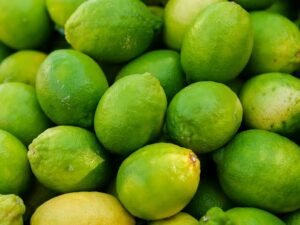India Exports First GI-Tagged Indi & Puliyankudi Limes to UK
|
General Studies Paper II: Government Policies & Interventions |
Why in News?
Recently, the Agricultural and Processed Food Products Export Development Authority (APEDA) facilitated the first-ever air shipment of GI-tagged Indi Lime and Puliyankudi Lime to the United Kingdom, showcasing the global recognition of India’s unique regional produce.
India’s First GI-Tagged Lime Export to the UK
- India has achieved a remarkable milestone in the field of agricultural exports with the successful air shipment of Geographical Indication (GI)-tagged Indi Lime and Puliyankudi Lime to the United Kingdom in October 2025.
- The initiative was coordinated by the Agricultural and Processed Food Products Export Development Authority (APEDA) under the Department of Commerce, Ministry of Commerce and Industry.
- The consignment consisted of 500 kilograms of fresh limes, which included 350 kg of Indi Lime from Vijayapura, Karnataka, and 150 kg of Puliyankudi Lime from Tenkasi, Tamil Nadu.
- This export is expected to pave the way for regular international trade of these limes, especially to markets like the UK and Europe, where demand for organic and naturally sourced fruits is increasing.
- Earlier in 2025, APEDA also facilitated the export of 3 metric tons (MT) of Swadeshi Indi Lime from Vijayapura to the United Arab Emirates (UAE), reflecting India’s steady progress in diversifying its export destinations.
Geographical Indications (GI) and Their Importance in Trade
- About: A Geographical Indication (GI) is a sign used on products that come from a specific geographical area and possess qualities, reputation, or characteristics that are directly linked to that place of origin. The concept recognizes that certain products derive their uniqueness from the region in which they are produced. These unique features are shaped by local factors such as climate, soil, traditional knowledge, and cultural practices.
- Objectives: GI protection ensures that only authorized users from that geographical area can use the registered name. This legal recognition prevents misuse or imitation of the name by producers from other regions. The purpose is to safeguard the authenticity and originality of traditional and regional products, both in domestic and international markets.
- Legal Framework: Geographical Indications are protected under the Geographical Indications of Goods (Registration and Protection) Act, 1999, which came into effect on September 15, 2003. The Controller General of Patents, Designs, and Trademarks functions as the Registrar of Geographical Indications.
- The registration process provides exclusive rights to use the GI tag for producers and cooperatives from the identified region.
- India’s GI Act also aligns with the provisions of the World Trade Organization’s (WTO) Agreement on Trade-Related Aspects of Intellectual Property Rights (TRIPS), which sets global standards for the protection of intellectual property rights.
- GI Products: India has a wide range of products that have received GI recognition, covering agricultural, handicraft, manufactured, and food items. As of 2025, India has registered more than 650 GI products, reflecting its rich cultural and regional diversity. Famous examples include Darjeeling Tea from West Bengal, Basmati Rice from northern India, Kanchipuram Silk Saree from Tamil Nadu, Mysore Sandal Soap from Karnataka, and Alphonso Mango from Maharashtra.
- Importance: In agriculture, GI plays a critical role in promoting regional products. It helps farmers earn better income by distinguishing their products from generic ones. It increases market visibility, enhances product differentiation, and allows premium pricing in both domestic and international markets.
Unique Features of Indi Lime and Puliyankudi Lime
- Indi Lime:
- Indi Lime originates from the Vijayapura district in northern Karnataka, located in a semi-arid zone with a hot and dry climate. The soil in this region is deep black cotton soil, rich in calcium and other minerals suitable for citrus cultivation.
- Indi Lime received its Geographical Indication (GI) tag in 2022.
- The Indi Lime is known for its medium size, bright green color, and thin peel. The fruit is rich in citric acid, which gives it a perfect balance of sourness and tanginess.
- It has a high juice yield, making it popular for both domestic consumption and export.
- The fruit’s balanced acidity and low bitterness make it ideal for culinary use.
- The harvest season generally occurs between June and September, when the fruit reaches full maturity.
- Puliyankudi Lime:
- Puliyankudi Lime, also known locally as the Kadayam variety, comes from Tenkasi district in southern Tamil Nadu. The region lies near the foothills of the Western Ghats and has a tropical climate with moderate rainfall.
- The soil is red loam mixed with limestone, which supports high fruit acidity and vitamin C content.
- It received its official GI tag in April 2025.
- The Puliyankudi Lime is easily recognizable by its thin peel and bright yellow-green color when ripe.
- It has a high ascorbic acid (Vitamin C) content, which boosts its demand in the food and health industries.
- The fruit contains about 55% juice, which is significantly higher than ordinary lime varieties.
- The pulp is soft and filled with a sharp tangy taste, making it perfect for juice extraction and pickling.
- The strong acidic flavor gives it a natural preservative property, useful in traditional cooking.
Significance of India’s GI Tag Exports
- Local Farmers Empowerment: GI-tagged exports can bring new opportunities for local farmers across India. These farmers depend on agriculture for their livelihood and often struggle with fluctuating prices and limited market access. The GI tag creates a unique market identity for their product and ensures fair pricing. Farmers benefit from higher returns because GI products often attract premium prices, sometimes 20% to 30% higher than non-GI goods.
- Rural Income Growth: The export of GI-tagged goods directly supports income growth in rural areas. Many villages depend entirely on the cultivation of region-specific crops or the production of traditional goods. The global recognition of these products improves income stability by creating consistent demand. The success of products like Kashmiri Saffron and Nagpur Orange shows how GI tags can transform rural economies.
- Rural Employment Opportunities: GI-tagged exports create a wide range of employment opportunities in rural regions. The process of cultivating, processing, packaging, and exporting these goods requires skilled and semi-skilled labor. This generates jobs not only for farmers but also for youth and women in villages. As rural employment increases, migration to cities reduces, strengthening village economies.
- Strong Trade Relations: GI exports play a crucial role in enhancing India’s trade relations with other countries. Global demand for authentic and traceable products has increased, especially in the European Union, United Kingdom, and Gulf countries. India’s ability to supply GI-certified goods strengthens its reliability as a trade partner.
- Enhance Global Image: In future, the global success of India’s GI products will help to shape the country’s international image as a hub of quality, authenticity, and heritage. When consumers abroad will purchase a GI product, they will associate it with reliability and craftsmanship. This perception further, strengthening “Brand India” in global markets.
|
Agricultural and Processed Food Products Export Development Authority (APEDA)
|
|
Also Read: Verification of Made in India Products |










